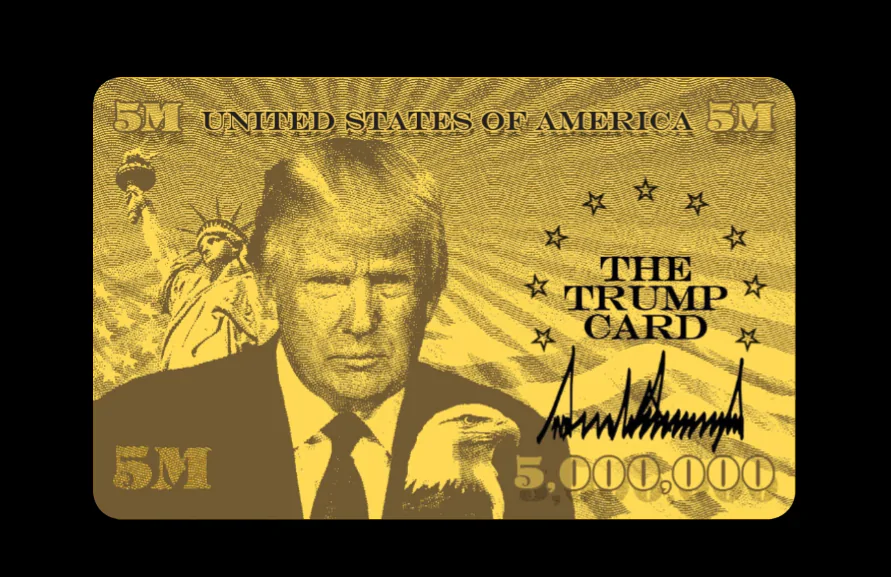On February 2025, US President Donald Trump announced a new investment migration initiative: the “Trump Gold Card.” Promising US residency and a pathway to citizenship with a minimum investment of $5 million, the program is positioned as an alternative to the existing EB-5 investor visa. Calling the EB-5 program “nonsense and fraud,” Trump also signaled that the “minimum 10 employment requirement” on EB-5 visas could be removed from the Gold Card program. Yet, as striking as its promises are, so are the uncertainties surrounding it.
Stating that the government could sell 10 million Gold Cards, which would help reduce the budget deficit, Trump said the Gold Card would be a more “high-level Green Card”. He argues that the Gold Card program does not require congressional approval as the Congress determines the criteria for US citizenship. Therefore, this has led to comments that Congress could be bypassed to implement the program.
In an interview with the Financial Times, Lutnick said he pitched the Gold Card to foreign dignitaries during his Middle East visit and encouraged them to buy in.
The website ‘TrumpCard.gov’ went live on June, 2025. As of the morning of June 17, 67,697 people had signed up for the waitlist; by the end of the call, the figure had reached 68,703.
What Does the EB-5 Visa Cover, What Is Planned to Change?
- Unlike the EB-5 investor visa, the Gold Card does not require job creation.
- EB-5 allows applicants to gain a Green Card with an investment between $800,000 and $1 million, provided it creates 10 full-time US jobs. In contrast, the Gold Card relies solely on financial contribution.
- The target audience of the EB-5 Visa is a wide range of investors while Golden Card consists of ultra-wealthy individuals.
- According to Commerce Secretary Howard Lutnick, the Gold Card will be made of real gold and will be 'beautifully designed.'
Big Promises, Thin Details: The Commercial Vision Behind the Trump Card
Lutnick claims the card will bring billions in revenue to the US Treasury and attract global business leaders and their high-skilled employees to America. However, the Department of Commerce has not released a detailed framework, with tax benefits and security screening requirements still unclear or unrevealed.
Sources close to the administration say tens of thousands of visas are planned to be sold this summer, despite the program currently existing only as a landing page.

It is still unknown how this card will compete with or impact the EB-5, a congressionally approved immigration program.
“Whenever I meet with international executives, I walk them through the card and sell it to them,” Lutnick told the FT. “I can’t help myself.”
Legal Uncertainty
A major question remains: can the administration launch such a program without congressional approval?
Article I, Section 8 of the US Constitution assigns authority over immigration laws to Congress.
Nevertheless, there are signs that the infrastructure is being integrated into US immigration systems, indicating the administration is pushing forward.
Elon Musk, who was involved in the rollout, previously stated the program was in a “quiet trial” phase to ensure system integrity before a public launch.
Wired reported that some US permanent residents and Global Entry applicants had already been asked if they had applied for the Trump Card. Yet, the website offers no information about an official launch date.
Tax Burden Flexibility for Foreign Investors with the New Visa Program
Another feature of the Golden Card that draws attention is that it offers foreign investors a tax advantage that US citizens cannot benefit from. By using “his parole authority”, Trump announced that individuals with Gold Card visas will be granted citizenship. However, it will exempt them from the US citizenship-based tax regime and not taxing their international income.
Currently, US citizens, permanent residents, and Green Card holders must pay taxes on their income in both the US and abroad, while the Golden Visa program provides that foreign investors will not be taxed on their external income. The exemption that comes with the Golden Card on tax brings the speculations of ‘hidden tax advantage for rich investors’. Thus, it eliminates one of the main factors that make it difficult for wealthy investors to transition to US citizenship.
General Framework of the Golden Card Visa Program
This system, which is planned to replace the current EB-5 program, aims to provide investors an access to obtain permanent residency and citizenship in the United States. According to Trump’s statements:
-
- It will strengthen the US budget,
- The high-net-individuals will enter the country,
- Investors will contribute to the real estate and job markets.
Economic Potential and Demand Concerns
The administration claims that selling one million Trump Cards could generate $5 trillion for the US Treasury. Trump described the card as a “strong route to citizenship,” though officials argue it falls under executive power because it does not directly grant citizenship.
Lutnick had projected a rollout within two weeks back in March, but no formal launch date has been confirmed.
Key Points
- Gold Card holders will receive permanent residency, similar to Green Card holders. The program offers a pathway to US citizenship. However, details of the process are not announced.
- Gold Card holders will have opportunities to start a business and invest in the US There is no detailed information based on the employment requirement.
- The US economy will benefit from this program through tax revenues and consumption spending.
- From Gold Card sales aims to reduce the national debt and attract capital to the US economy.
- The Gold Card program creates a two-tier system in the US immigration system based on wealth.
- The US imposes the highest financial entry requirement ever in the immigration process. The Trump administration argues that this program will grow the US economy.
Key Differences of Gold Card and EB-5 Visa
Comparison of the USA’s New Gold Card Visa and Golden Visa Programs in Europe
There are ‘Golden Visa’ programs that provide residency by investment in many countries such as Portugal, Greece, Italy and Malta. By comparison, the Gold Card Visa is positioned as the most expensive investor visa in the US, with an investment requirement of $5 million, while European countries and other investment immigration programs offer accessible options with lower investment thresholds. On the other hand, unlike other Golden Visa programs, the Golden Card Visa program stands out by offering a flexible tax regime that eliminates the tax burden on foreign income.
While the US targets only ultra-wealthy investors with the highest investment requirement, programs in Europe can attract investors with much lower budgets. This makes the US program attractive only to high-end investors, while European Golden Visa programs cater to a wider range of investors.
Let’s consider in detail the differences between the high investment requirement and the tax exemption advantage of the USA:
The $5 Million Shortcut: Is the Trump Gold Card a Real Alternative to EB-5?
The $5 million Trump Gold Card could appeal to wealthy individuals seeking a faster path to US residency. In contrast, many investors still view the EB-5 visa, which grants Green Cards in exchange for $800,000 to $1 million investments and the creation of 10 full-time jobs as a proven, though slower, route into the US.
While the EB-5 is often criticized for heavy bureaucracy and lengthy source offunds verification processes, the Gold Card offers a radically simplified alternative with no job creation requirement. However, the lack of detailed guidance on eligibility, tax structure, or background screening continues to cloud its credibility.
Despite high expectations, the implementation path remains murky. While the TrumpCard.gov registry has launched, core components like tax advantages, vetting protocols, and legal thresholds have not been publicly defined. This raises critical questions about how ‘real’ the program is from a legal and administrative standpoint.
Although the program’s infrastructure has reportedly started appearing in government systems, the absence of any legislation has led critics to conclude that the Trump Gold Card remains at the level of political marketing.







